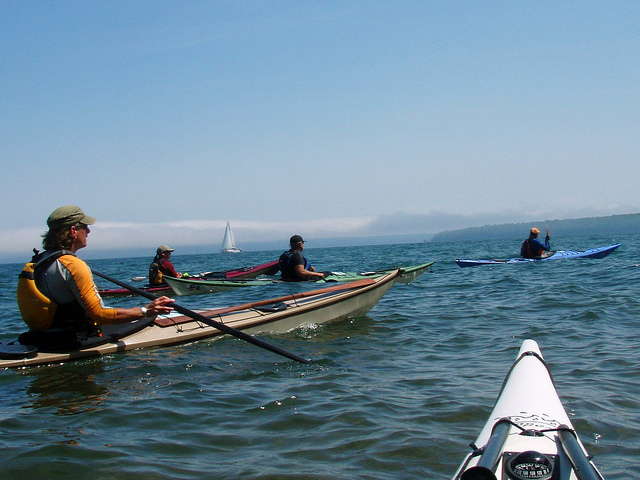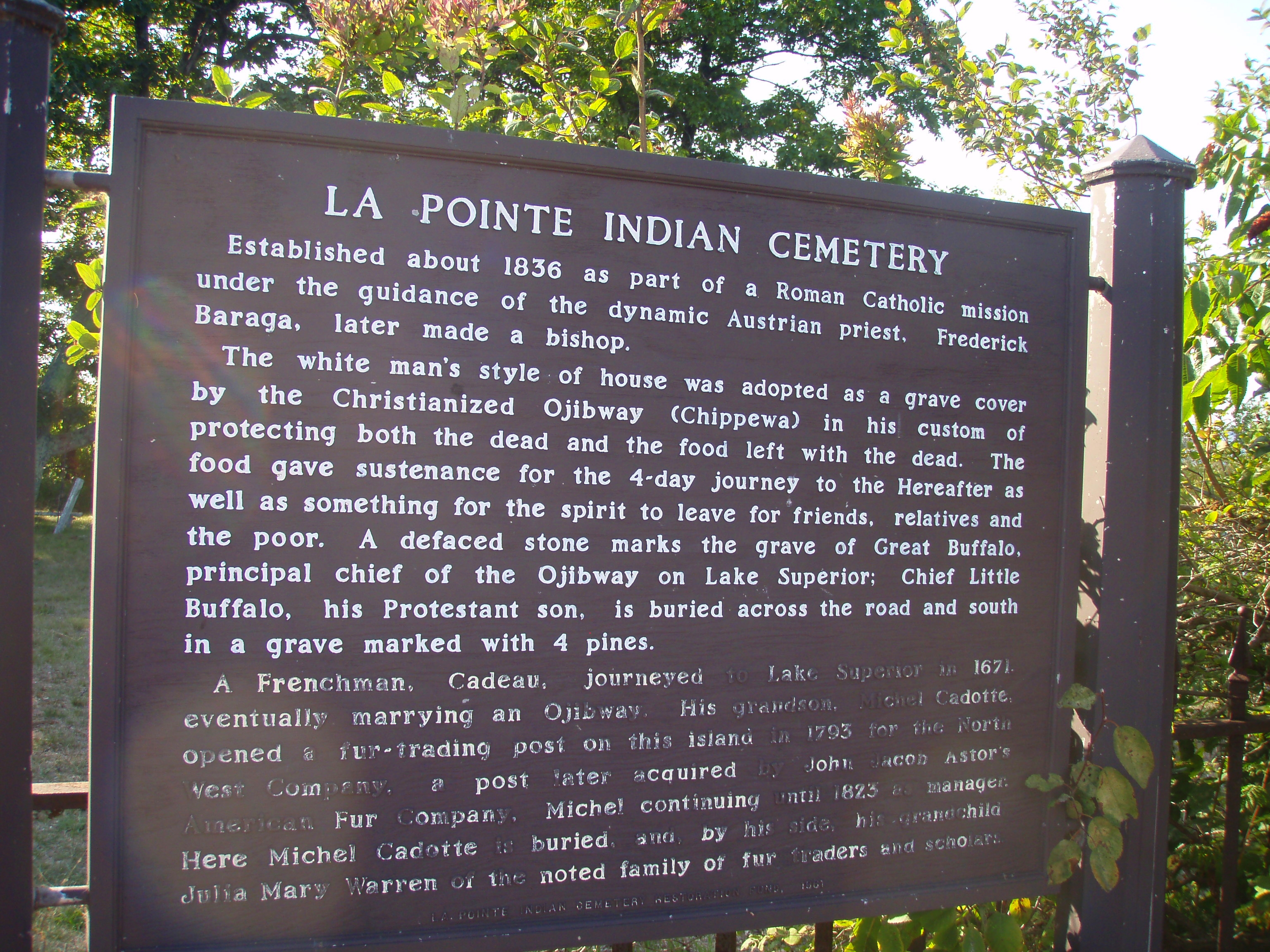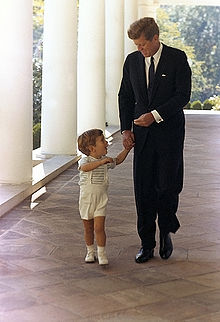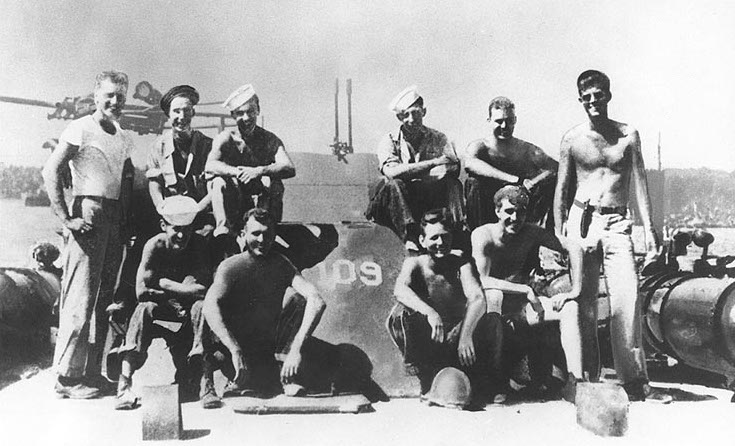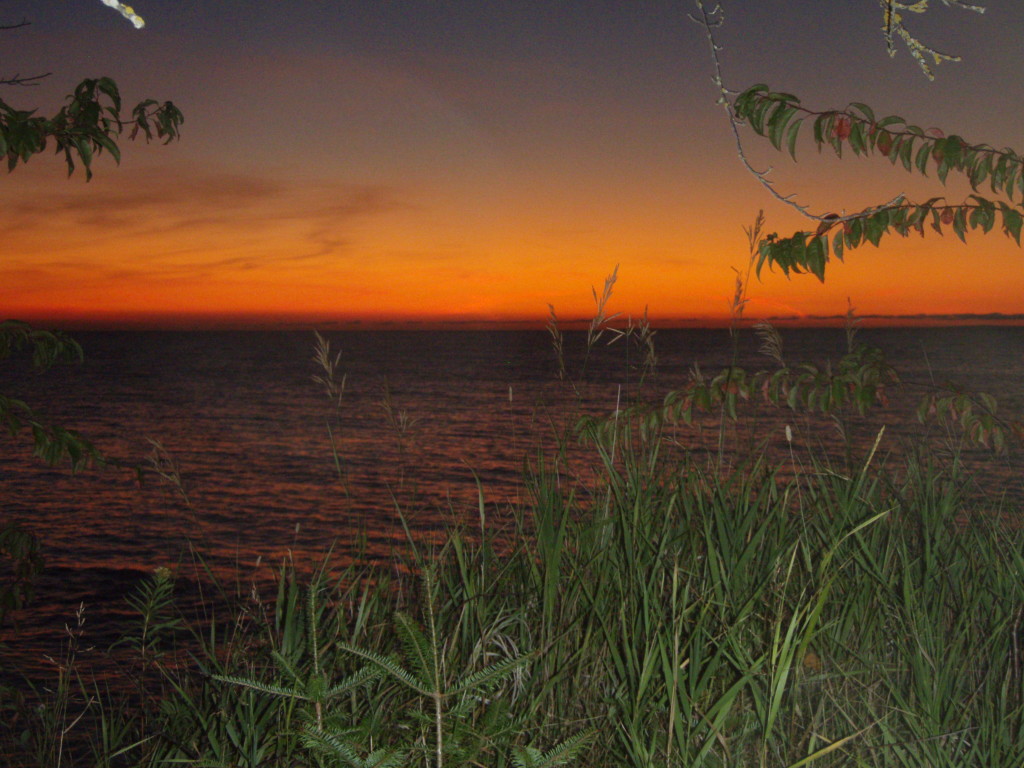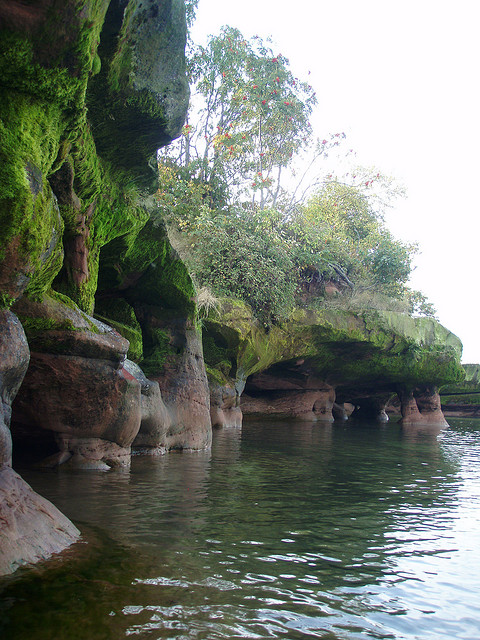 Paddling around Eagle Island, 2009; the island is protected by Critical Species Natural Area.
Paddling around Eagle Island, 2009; the island is protected by Critical Species Natural Area.
Last fall, on September 24th, Chequamegon Bay JFK Day marked Kennedy’s visit to the Apostle Islands area thirty years ago (Sept. 24, 1963). Chequamegon was applied to the region by traders and missionaries which derives from a Chippewa(Ojibwe) word, shagwaumikong, meaning soft beaver dam.
Harold C. Jordahl, Jr., who was directly involved in events surrounding the establishment of the Apostle Islands National Lakeshore in the 1960s, put together a manuscript in 1994 which includes a chapter about Kennedy’s visit to the Apostle Islands as well as a chapter on the history of the Native Americans to enable a better understanding of their influence on the final legislation.
Not many people are aware of the Apostle Islands–their uniqueness as an archipelago in the Great Lakes. So when Kennedy did his tour I persuaded him to fly over to Ashland. I flew with him along with Hubert Humphrey and Gene McCarthy… we flew by helicopter from Duluth. …Fortunately, as we were flying over a bald eagle comes off to one side. We landed; there was a big crowd. He gave a speech including an endorsement of the idea of saving the Apostle Islands, so that got it at the presidential level and, of course it would be noticed by the park service and everybody else. Then the president was assassinated. Gaylord A. Nelson (18; Jordahl, p. 251)
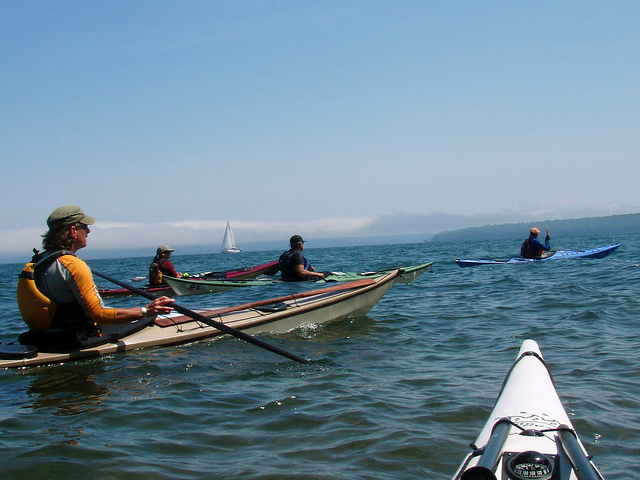 Paddling with Eila Wilkenson (2nd left) and Nigel Dennis (3rd left) around Oak Island; 2011.
Paddling with Eila Wilkenson (2nd left) and Nigel Dennis (3rd left) around Oak Island; 2011.
My first sea kayaking included several trips to the Apostle Islands. In 2011, I met up with Eila Wilkenson and Nigel Dennis from the UK for a paddle around Oak Island at the Inland Sea Symposium. The Inland Sea Society is a self-sustaining organization that works on projects promoting environmental stewardship through education and recreation, sustainable communities, and watershed-based organizing. The goal of the Lake Superior Water Trail is to eventually link Minnesota, Wisconsin, and Michigan in the United States, Ontario in Canada, and many First Nations in both countries.
Gaylord Nelson was instrumental in establishing the National Trails System, the Wilderness Act, and Earth Day. In 2004, the Gaylord Nelson Wilderness was established. It is a 35,000-acre wilderness area located within Apostle Islands National Lakeshore, off the Bayfield Peninsula of northern Wisconsin. Of the twenty-two Apostle Islands the wilderness area fully or partially covers eighteen and provides opportunities for camping, hiking, sailing, kayaking, and fishing.
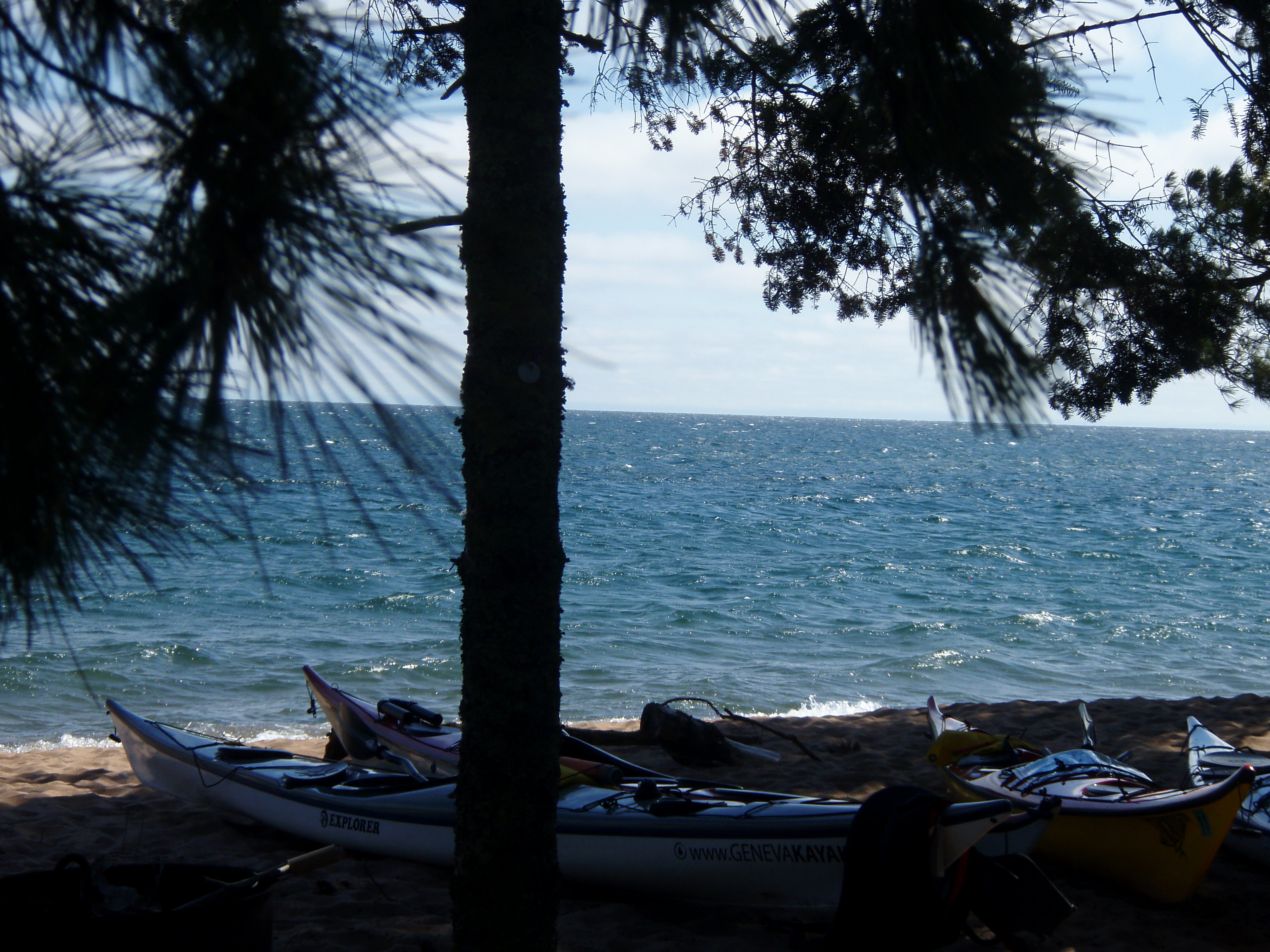 Outer Island, Apostle Islands National Seashore. 2009.
Outer Island, Apostle Islands National Seashore. 2009.
In the picture above, my group was anxiously awaiting the wind to develop some nice surf to play in later that day. It was so windy that day that most of us went to the lee side of the island and napped once we had landed. The north ends of Devil’s Island and Outer Island are exposed to the full fetch of Superior in all directions. Wave heights of 8 to 10 feet are not uncommon with a strong northeast wind even in summer months. Always check the marine forecast. Coastguard approved PFDs are required and a wetsuit is also recommended because the water temperatures are often less than 50 degrees. Fog can be a problem, too, and it is important to have a chart and compass for your crossings (Nautical Chart # 14973).
In general, sea kayaking is considered a very primitive form of boating and is not necessarily appropriate for large numbers of people. But for the natural constituency of mariners who are drawn to kayaking, most sea kayakers can average 3 miles/hour in a loaded boat. Given this average speed you can expect to cover 20-21 miles/day with 7 hours of paddling and some stops–about 100 miles/week.
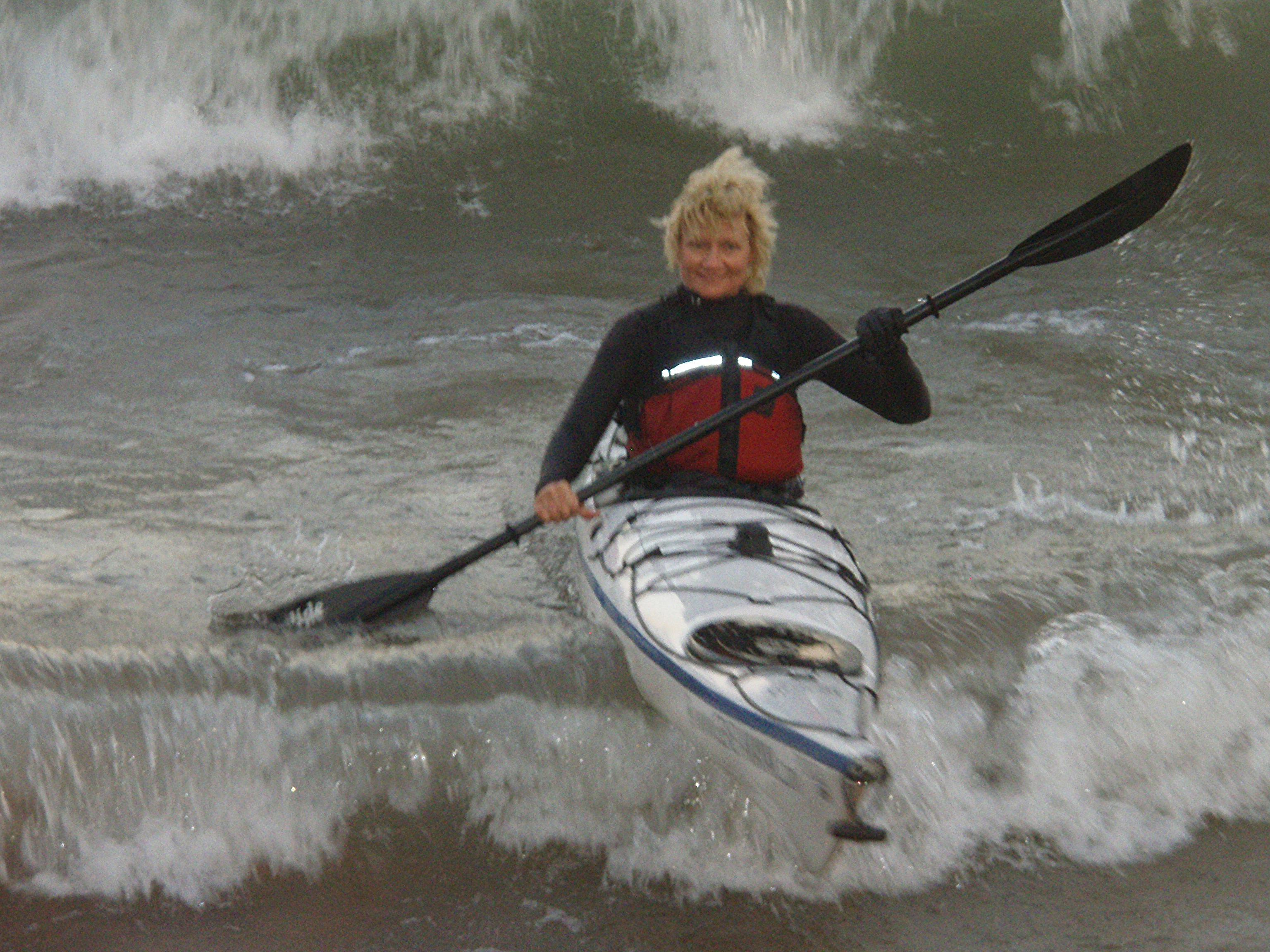 Taking in the surf on Outer Island; 2009.
Taking in the surf on Outer Island; 2009.
When I took the ACA L3 sea kayak Door County Instructor Development with Sam Crowley, he assigned the topic waves in deep water for me to teach. I knew Sam, of Marquette’s Sea Kayak Specialists, had spent a lot of time in the Apostles years ago and I asked if I could use his “well-worn chart” to discuss the locations where you could most likely find the largest surf and when (video of Sam surfing in Marquette).
Due to the rapidly changing weather conditions canoes and small open boats are not recommended for use between the Apostle Islands and excursion cruises are offered for island tours. My first sea kayak tour out of Duluth was to include the sea caves in the fall of 2006. In fall and spring the risk of hypothermia is high and this was the first time I had paddled in a wetsuit and used a sprayskirt. After spending the morning in a protected area we had lunch and attempted to paddle near the sea caves but not to them since the water was beginning to get choppy in the gusts of wind that had started. Within the first five minutes three of the boats capsized and the paddlers swam back to shore and chose to remain huddled next to their boats out of the wind to stay warm as the rest of us circled around and headed back. (see another important report by Haris Subacius: Cold Water Trumps Young Hot Blood)
Today, if you are planning to tour the sea caves you can use your smart phone and check the live conditions report at SeaCavesWatch.org. The site also displays water temperature and photos of the waves at the sea caves, and it relays wind speed recorded at Devil’s Island. For more information on kayaking at the Apostle Islands check the National Park Service website.
La Pointe Indian Cemetery ; 2009.
After my 9-day kayak expedition of all of the Apostle Islands in 2009, I spent some time on Madeline Island. The Christianized Ojibwe are buried in the La Pointe Indian Cemetery(pictured above) where spirit houses have been erected to protect food left for the dead for sustenance for their four-day journey to the hereafter.
The Ojibwe are one of the largest groups of Native Americans north of Mexico. They are divided between Canada and the United States today where legal arguments in treaty-rights and treaty interpretations often bring to light the differences in cultural understanding of treaty terms to come to legal understanding of the treaty obligations. The Ojibwe believed that land was a fully shared resource, along with air, water and sunlight, they could not conceive of separate land sales or exclusive ownership to land.
The Ojibway remained on La Pointe for three generations (120 years) and then there was a complete and sudden evacuation at that time, writes William W. Warren, in his book History of the Ojibway People (pdf link). William, who is half Ojibwa, writes that there was a very dark period in the Ojibwe history that scattered them in bands on the adjacent shores of the Great Lake and sent many families back to their former migration. During this time, their medicine men had started initiating cannibalistic feasts which became vogue and custom. From that time on the Ojibwa considered the island to be haunted and never resided on it until the French traders came and built their trading establishment there. (Warren; 23, p. 108, 109.)
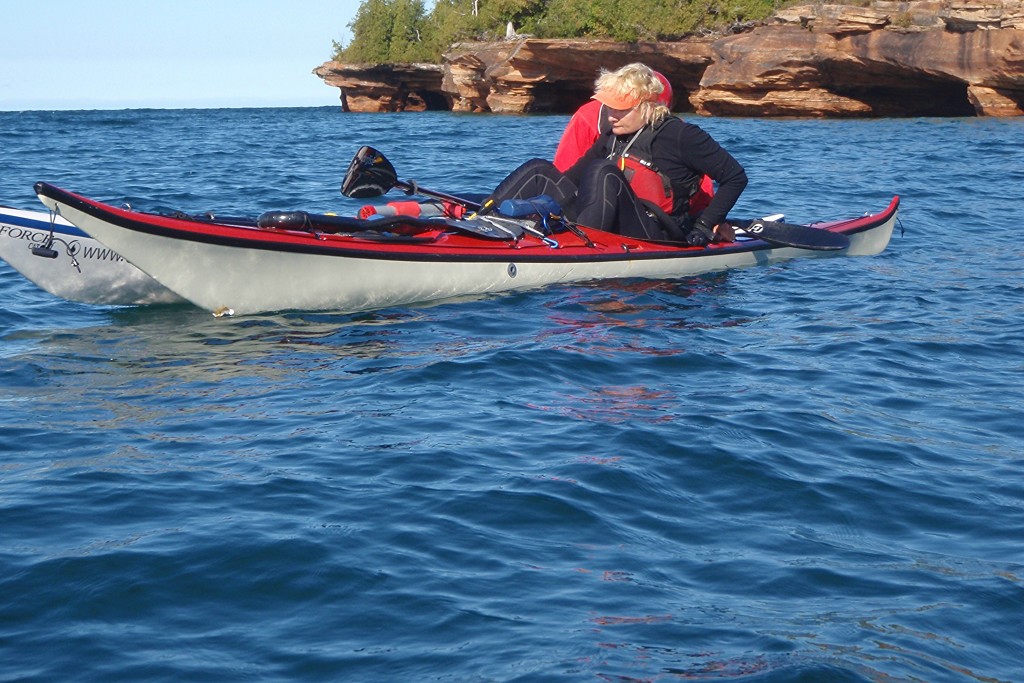 Switching boats before we surf some incoming swell at Devils Island.
Switching boats before we surf some incoming swell at Devils Island.
The Apostle Islands were strategic for defense, sustenance, and trade. Because the water level of Lake Superior rose and fell several times during the past glacial ages, beaches which might have provided ancient campsites are found near the highest islands, Oak and Bear, or submerged below today’s waterline.
Devils Island (pictured above) rests atop many natural caves. The name comes from the large booming sounds created from air pockets that form under the island that the natives attributed to angry spirits. Many of the Great Lakes and Northeastern Woodlands Native American tribes believe that there are several water beings. According to Native American mythologies of the Great Lakes, underwater panthers are described as water monsters that live in opposition to the Thunderbirds, masters of the powers of the air. Underwater panthers are seen as an opposing yet complimentary force to the Thunderbirds, and they are engaged in eternal conflict.(31)
Dr. Timothy Pauketat, who has been a part of the “Mississippian Initiative” (funded by the National Science Foundation), is currently working in western Wisconsin where they now argue for the existence of a short-term Cahokian mission or colony. Presumably, the effects of Cahokians missionizing the ancient north country led to profound long-term change in the ancient American Indian world. Their work in Wisconsin, and future work at and around Cahokia, will attempt to ascertain the relationship of religion to ancient politics more generally.
On the basis of Pauketat’s work we now know that Cahokia rose and fell over a much shorter time period, around three hundred years, than had been previously attributed due to improvements in radiometric dating and new methodologies such as identification of domestic remains. Dividing up the artifacts by radiometrically dated and ceramic-seriated phases, he notes an increasing number of foreign goods as time progresses in the Emergent Mississippian phases. He has interpreted this growth as an enlargement of high-ranking peoples able to secure such networks necessary to move such goods as Gulf Coast shell from distant locations.
The emigrants from Cahokia began building in Northern Illinois just before moving up the Mississippi and Rock River valleys to Wisconsin in about A.D. 1,000. For 200 years, Cahokia was the largest urban center north of Mexico–the political capital of the culture we call Mississippian. Although the Mississippian culture was fading by the time the first Europeans arrived it had spread north to Wisconsin and into the Ohio and Tennessee Valleys–many of its elements had reached Georgia, Alabama, and North Carolina. The Mississippian peoples raised huge pyramidal hills and left strong evidence of a powerful class of ruler-priests. The 16-acre base of Cahokia’s Monk’s Mound surpasses that of Egypt’s Great Pyramid. (Kennedy; 40, p. 93)
Every village was a link in an elaborate network of trade that extended over hundreds of miles… from the highlands of the interior down the Gulf and Pacific coasts…The mythical spirits that controlled the destines of the villages were worshiped through human intermediaries–men of high rank who maintained the shrines. (1; p. 287)
Those who conducted village rites among the Aztecs were closely engaged in the importation of the special and exotic shells they needed. Sixteenth century chroniclers have described how Aztec priests used stingray spines to draw blood from their bodies. The more eminent one’s rank, the more torture was necessary. The objects of commercial and religious significance found suggest that they gained power over public religion and, to some extent, economic life. The state was in this way set for the emergence of a priestly ruling class with potentially great economic and sacred powers. Their religion worked as Islam does, uniting people of divergent cultures through a common and fervently held belief. (1)
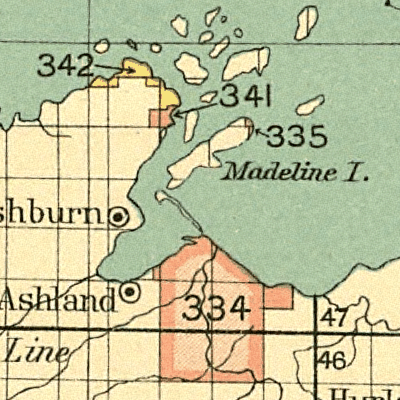 Early map of Chequamegon Bay.
Early map of Chequamegon Bay.
According to the oral history of the Anishinaabeg, they began their migration from the East Coast some time around 950, stopping at various points several times along the way, most significantly at Sault Ste. Marie, where they stayed for a long time, and where two subgroups decided to stay. Eventually the other clans traveled West and arrived at the wild ricing lands of Minnesota and Wisconsin and made Madeline Island their new capital.
Following the migration there was a cultural divergence separating the Potawatomi from the Ojibway and Ottawa. The Potawatomi did not adopt the agricultural innovations discovered or adopted by the Ojibway and they also divided labor according to gender much more than the Ojibway and Ottawa did.
The Ojibwe believe that spirits guide them through life and they have passed down a number of spiritual beliefs by oral tradition under the Midewiwin teachings. Generally two-spirit men practiced Shamanism and it was taboo for women to take on this role, but a two-spirit following this path was called an Iron Woman. “Iron Woman” or “Half Sky” is the Ojibwe Two-Spirit woman who takes on men’s rolls. The Half Sky two-spirit would be physically good at man’s trade. Also, there is an instance when a wife becomes widow and takes on her husband’s manly deeds; this woman is called a “Woman Covered All Over.”(27; Wikipedia)
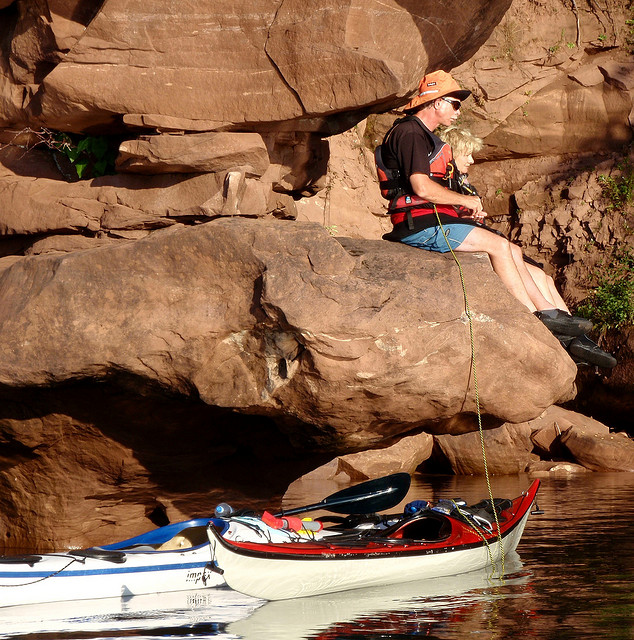 Picture courtesy of Tony Erickson: John Martin, Mary Fairchild. Apostle Islands, 2009.
Picture courtesy of Tony Erickson: John Martin, Mary Fairchild. Apostle Islands, 2009.
In the summer of 1928, Selwyn Dewdney accompanied his father, who was an Anglican bishop, on a 3,800 mile journey, mostly by canoe, to visit the Ojibwa and Cree missions in Northern Ontario. Later in life, while exploring Northern Ontario, Dewdney discovered ancient native pictographs painted in red ochre and was able to help record them with the curator of the ethnology department of the Royal Ontario Museum, Kenneth E. Kidd. After visiting 301 sites in Canada and the U.S., his first edition of Indian Rock Paintings of the Great Lakes was published, with Kenneth Kidd as co-author.
Red ochre made from ground hematite was sometimes sprinkled over the human remains and artifacts. The distinctive Red Ochre Mortuary Complex, originally defined by archaeologists working in the central Illinois River valley, occurs across the southern Great Lakes region at the very end of the Late Archaic period.
During the late archaic period, things were obtained through long distance trade including marine shell from the Atlantic and Gulf Coasts, hematite and magnetite from the Ozarks, copper from Lake Superior region, galena from the Upper Mississippi River Valley and southeastern Missouri. Elaborate artifacts found in the graves of some people suggest that these individuals had a special status.
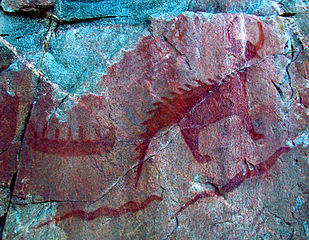 Agawa Rock, Lake Superior Provincial Park.
Agawa Rock, Lake Superior Provincial Park.
In 1980, two stands of white pine were planted at Agawa Bay in Lake Superior Provincial Park to honor Selwyn Dewdney. A plaque erected by the family stands against the Shield rock he loved so much, a few meters away from the Ojibwe pictograph of the underwater panther Mishibizhiw. Mishibizhiw translates into “The Great Lynx.” It has the head and paws of a giant cat but is covered in scales and has dagger-like spikes running along its back and tail. Michipicoten Island in Lake Superior is said to be his home and he is a powerful creature in the mythological traditions of some Native American tribes.
The Ojibwe revered copper and associated it with Mishibizhiw to which offerings were made for safe canoe passages across the lakes. They also used copper tablets to record clan genealogies. People began mining copper as early as 4500 BC at Isle Royale. Much of the mining was along the Minong Ridge which the early people, and more recently the Ojibwe, reached by canoeing into McCargoe Cove. (Kennedy; 40, p. 19.)
During Kennedy’s visit to the Apostle Islands in 1963, he had commented on how much the Apostle Islands had reminded him of Hyannisport, Massachusetts, where he grew up, sailing nearly every day in the Atlantic. The public image of the Kennedy White House, cultivated by the emerging power of television, was one of glamour and high culture. JFK was born into great wealth and almost all of his income and property came from a trust shared with other family members. His wife was an oil heiress and his father was one of the wealthiest men in America and was the first chairman of the Securities and Exchange Commission (SEC).
When families belong to the local elite and social, religious, moral, and cultural capital is abundant and generously transmitted to them, they often struggle to develop an identity of their own. Not only is it very difficult for high-profile people to be taken seriously, but the amount of coverage they get is often disproportionate to what they merit which in turn feeds the outsize egos most celebrities possess.
High-profile children, children of clergy in particular, often experience pressure due to the expectations placed on them which are known to develop feelings of inner conflict as a result. Living in the public eye, they had to cope with possible discrepancies between ‘front-stage’ and ‘back-stage’ behavior by their father and whether they liked it or not, they were watched and had to set an example for others which made them feel like they were public property. Often, this feeling could lead to rebellion or over-adjustment. Southern Literature of the United States has been filled with these rebellious children of the clergy and this view is seen as a stereotype. (15)
Staying at Gruenke’s Inn, John Kennedy, Jr., traveled to the Apostle Islands to kayak for a few days with friends the year before the plane crash which claimed his life and the lives of his wife and sister-in-law. On his fateful day, he had a big weekend ahead of him as he planned to fly to Hyannis Port to attend the Saturday wedding of his cousin, but, he would never make it. That morning he had met with his publishing partner to discuss his magazine amid rumors that funding was to be turned off and that the company had lost confidence in it. He also just had his cast removed the morning prior due to a broken his ankle from a paragliding accident six weeks prior. Adding to that list, not only was his take off later than usual, but a local pilot had canceled a planned flight because of a troubling haze that had already reduced visibility.
As a test that most pilots use at the airport, the pilot decided to ground himself when he looked off in the distance for a familiar mountain ridge but couldn’t see it. Regardless of this information, just after Carolyn arrived, she, Kennedy and Lauren boarded the Piper Saratoga and were cleared for takeoff at 8:38 p.m., 12 min. after sundown. Other pilots began flying into the same soup up and down the coast and began to radio in for alternative landings, but Kennedy never made radio contact throughout the trip and 48 min. after takeoff, according to radar records, he suddenly began to descend at a quicker than normal speed. He had only gotten his pilot license 15 months prior and without a practiced ability to read all the instruments his plane was plummeting toward the water at 5,000 ft. per min. (10)
Edward Klein, a confident of Jackie Kennedy Onassis, writes in his best selling book, The Kennedy Curse, that the Kennedys felt immune to normal laws with near divine protection from the consequences of their actions.(12)
Kennedy (far right) with his fellow officers, many of them Ivy League graduates.
Kennedy’s performance in office rose to a mythical status in part by how he died. During his lifetime rumors were contained, and what Americans saw of him was an image due to the emerging power of television and media.
Due to severe health problems, in 1940, the U.S. Army’s Officer Candidate School had rejected JFK as 4-F, citing ulcers, asthma, and venereal disease. Most debilitating, doctors wrote, was his birth defect—an unstable and often painful back.
He was in constant pain most of the time but his father was able to pull a few strings on his behalf. Author and historian Nigel Hamilton shares with the History Channel, “JFK really got into the Navy through his father who twisted the arm of a previous Naval attache who had served with him in London. At that stage no one was ever thinking that he’d see action so he was given a very light doctoral examination in Boston and really never had to reveal his whole background.”
Instead of being shipped off to a war zone, John was ordered to join a PT boat squandran in Panama where he would soon be nick-named “Crash Kennedy.” According to Michael J. Bell, President of Historic Reflections, one day when he was coming in from patrol he decided to race another PT boat(torpedo-loaded boats) into the docks but when he tried to cut the engines he wasn’t able to and crashed into the dock.
Thomas C. Reeves, Ph.D., Wisconsin Policy Research Institute, adds that it was a terrible disgrace and if he wouldn’t have been court marshalled he certainly would have been in deep trouble but he wasn’t because they understood that he was “the ambassador’s son” so he got away with that.
During JFK’s campaign, Kennedy had gone to Las Vegas to visit the Rat Pack including Kennedy’s brother-in-law, Peter Lawford. While staying at the Sands Hotel he began an affair with Judith Kendel who was also the mistress of Chicago’s Sam Giancana, one of the mob bosses the CIA would later recruit to kill Castro. According to NBC Whitehouse Correspondent, Sander Vanocur, the Justice Department was in the hands of JFK’s brother Robert and the Kennedy brothers, assisted by FBI director J. Edgar Hoover, who had no qualms about using their power against their political opponents. J. Edgar Hoover was a black mail artist who had been practicing illegal wiretapping for years and this was allowed to expand drastically under JFK. Not only did Robert Kennedy use the wiretaps against the Mafia and other underworld types, but he also authorized spying on public figures. (19)
Since Kennedy’s presidency a covert system began that continues to increase in our country under every U.S. president; a secret structure that steers defense and foreign policy behind the facade of democracy. It is a political system which resorts to decision-making and enforcement procedures outside as well as inside those sanctioned by law and society–a covert system that is outside public awareness– Peter Dale Scott, Ph. D, a former Canadian diplomat and English Professor at the University of California, Berkeley. (Scott; 29)
In addition to their status as U.S. citizens, many American Indians are also members of federally recognized sovereign nations that, in theory, have the authority to manage their environmental problems independently. As tribal lands struggle with environmental problems, it is estimated that the success of clean-up programs will depend on continued dialogue between the tribes, the states, and the federal government; consistent and targeted funding; and understanding of cultural differences.
The EPA and other federal agencies operate within their own systems, which can act to impede relationships when the tribes don’t understand their bureaucratic language and methods. For example, Indian leaders are typically very concerned about the lives of their people on an individual level, and it isn’t uncommon for a tribal leader to sit by the bedside of a terminally ill member. Because each member of a tribe is vitally important, tribal leaders may be uncomfortable with the EPA’s impersonal, numerical estimates of acceptable risk. Tribes are building considerable expertise in risk assessment, however, and are providing the EPA with recommendations on how to improve risk assessment and risk-based decision making. (38)
In the 1970s a full national Indian movement was in swing. Beneath all of their protests was the issue of returning to the ceremonial use of the lands and raising the question of people and their right to a homeland. The late Stan Jones, a longtime Lake Powell historian and an Arch and Bridge Society board member, stated, in relation to the conflict at Rainbow Bridge, “There are legal reasons for restricting access to a particular site on public land, but religion is not one of them.” (9)
In 1974, Navajo tribal members who lived in the history of Rainbow Bridge filed suit in U.S.a District Court against the Secretary of the Interior, the Commissioner of the Bureau of Reclamation, and the Director of the National Park Service. The suit was an attempt to preserve important Navajo religious sites that were being inundated by the rising waters of Lake Powell. The court ruled against the Navajo, saying that the need for water storage outweighed their concerns. In 1980, the Tenth District Court of Appeals ruled that to close Rainbow Bridge, a public site, for Navajo religious ceremonies would violate the U.S. Constitution which protects the religious freedom of all citizens.
Today, the National Park Service asks visitors to be respectful of its significance to the people who have long held Rainbow Bridge sacred. It is not illegal, however, for visitors to approach and walk under the bridge from one side to the other along or just above the creek bed, and there is a well-worn path under the bridge that is regularly used.
References/Related–Mfairlady.com Paddle/Play
- Lionel Casson, Robert Claiborne, Brian Fagan, and Walter Karp, “Mysteries of the Past,” American Heritage Publishing Company; 1977.
- Gary King, Editor’s post: JFK Day provides an environmental message driven by the mystique of it all, 9/25/13.
- Nigel Hamilton, “JFK’s Reckless Youth.”
- John F. Kennedy; Historynet.com John F. Kennedy
- Huffinton Post, “Document Found at Connecticut Prep School May Shed Light on Origins of JFK Speech,” 11/04/11.
- Gaylord Nelson, Earth Day.
- 35th President– 1961-1963; By Norman Stone , Tuesday 20 January 2009 .
- Wikipedia; Motor Torpedo Boat PT 109.
- Mary Fairchild, Climbing Devils Tower in June With Andy Petefish.
- Jeffry Klugger and Mark Thompson, “The last day: The final 24 hours J.F.K. Jr.’s life were a typical whirl for someone used to the limelight. But in that very ordinariness lay the seeds of disaster.” CNN.com; Time: The Last Day 7/26/99.
- “Former Girlfriend Recalls Near Fatal Kayak Trip With JFK Jr,” 3/3/11; Vanity Fair.
- The Kennedy Curse, Edward Klein, St. Martin.s Press, 2003. Pg. 23
- Ibid., Pg. 10.
- John Kennedy: A Political Profile, James M. Burns, Harcourt, Brace & World, Inc. N.Y., 1961, page. 24.
- Wikipedia, “Preacher’s kid.”
- Laurence Gonzales, “Deep Survival: Who Lives, Who Dies, and Why.” W.W. Norton & Company; 2003. p. 254.
- G. William Domhoff, “The Myth of Liberal Ascendancy.”
- Harold C. Jordahl, Jr., “A Unique Collection of Islands: The Influence of History, Politics, Policy, and Planning on the Establishment of the Apostle Islands National Lakeshore.”
- The History Channel, “JFK: A Presidency Revealed,” DVD and Pdf., 2003.
- John-Brian Paprock & Teresa Peneguy Paprock, “Sacred Sites of Wisconsin,” Trails Books; 2001. p. 105.
- Bill Newman, Sarah Ohmann, & Don Dimond, “Guide to Sea Kayaking on Lakes Superior & Michigan,” Globe Pequot Press; 1999.
- Mary Fairchild, Sea Kayak Specialists’ Sam Crowley of Marquette: Door County Instructor Development
- John O. Holzheuter, “Madeline Island & the Chequamegon Region.” The State Historical Society of Wisconsin; 1986.
- Mary Fairchild, Sea Kayaking and Whitewater: Roughing it with Scott Berry and Nigel Dennis.
- William W. Warren, “History of the Ojibway People,” Minnesota Historical Press; 1984.
- Timothy Pauketat , “Cahokia: Ancient America’s Great City on the Mississippi.”
- Wikipedia, “Ojibwe people.”
- Mary Fairchild, Old Copper Culture: A Visit With Pete Stark .
- Peter Dale Scott, “Oswald, Mexico, and Deep Politics.” Skyhorse Publishing, 2013.
- Townsend, Richard F. (2004). Hero, Hawk, and Open Hand. Yale University Press.
- Reilly, F. Kent; Garber, James; Steponaitis, Vincas P., foreword (2004). Ancient Objects and Sacred Realms. Austin, Texas: University of Texas Press. pp. 29–34.
- Wikipedia, “Underwater Panther.”
- Alvin M. Josephy Jr., “The Custer Myth;’ Life, July 2, 1971. p.52
- Pearce, Roy Harvey (1965). The Savages of America: The Study of the Indian and the Idea of Civilization. Baltimore: Johns Hopkins University Press. pp. 191-192.
- Ralph Forquera, M.P.H. “Urban Indian Health.” November 2001, The Seattle Indian Health Board.
- Morris Thompson. 1977. Washington History Online: Indian Rights: Based on Treaties not racial issues.
- Margie Sue Hopkins. 2/20/07. A Current Issue Between Native Americans and Federal Government.
- Del Quintin Wilber. The Washington Post, 6/11/08. What is Owed to Native Americans?
- Native Americans and the Enviroment. 3/18/09
- Deloria, Vine. “God Is Red: A Native View of Religion.” Fulcrum Publishing, 1992.
- Francis H. Kennedy, “American Indian Places,” Houghton Miffin Company; 2008.
- International Sea Kayak Guide Snubs Registered Maine Guides: American Canoe Association’s Cover-up

